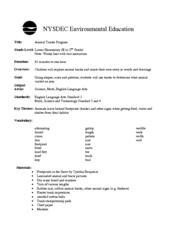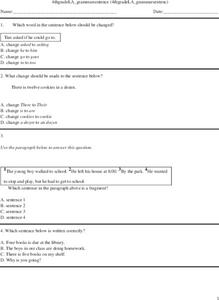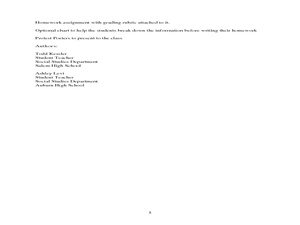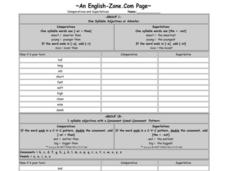Southern Nevada Regional Professional Development Program
Common Core Reading Standards: Understanding Argument
What does your class know about logical fallacies? They can find out quite a bit and practice identifying logical fallacies if you follow the steps and use the resources provided here! After reviewing ethos, pathos, and logos, ask small...
Curated OER
Desert Views: First Impressions
Students are introduced to primary source material and the ways in which early travelers viewed aspects of the desert environment. The activity addresses the geography themes of location, region, and human/environment interaction.
Curated OER
Learning Refrain and Verse
Instruct your young musicians on the terms verse and refrain. They listen to two songs, and point out the verse and refrain as they occur. Students then play drums when they hear the verse and the refrain. Note: Song lyrics, sheet music,...
Curated OER
Reading Poetry
Present your class with an overview of poetry-related information. The slides are clearly organized by topic, starting with reading poetry, ending with myths, and touching on everything from the five senses to open and closed forms of...
Curated OER
Stop Signs, Musical Notes, Letters & Logos: Designing Symbols
Students develop an awareness of environmental print, such as signs, logos, brand names, and other print and non-print items that the children see and read in their neighborhood each day. They then engage in active problem solving as...
Jordan School District
Who is Worth More Than Gold?
Young writers compose an opinion piece that details who they feel is worth more than gold.
Curated OER
100th Day Celebration
Pupils celebrate the 100th day of school with a variety of math and language arts activities based on the number 100. They make books, count objects, and draw their predictions about life 100 years from now. They also estimate the...
Curated OER
ESL: Body Parts Matching
Match drawings of basic body parts with their names. A handy tool for teachers of beginning ELLs.
Curated OER
Periodic Table of the Elements
First graders discuss, at their level, the concept of elements making up all matter. They discover the story of Dimitri Mendeleev and his discovery of the Periodic Table of the Elements. They locate and color some of the most common...
Curated OER
ESL Picture/Idiom Matching Worksheet
In this ESL picture to idiom matching worksheet, students examine 7 small clip art images before matching them to the idioms they best represent. They work with idioms such as "blood is thicker than water," and "as you make your bed, so...
Curated OER
Telling Time as an Everyday Use of Numbers
How can we estimate time? Have your young mathematicians make a clock. Then they compare and contrast types of clocks. They practice writing times in two different ways and make a book about telling time.
Curated OER
Animal Tracks Program
Entice your learners with this lesson plan on animal footprints. After reading the story Footprints in the Snow by Cynthia Benjamin, they use photos to identify animals and their footprints. Then they participate in an activity to...
Curated OER
Linear Piecewise Functions
Students explore the concept of piecewise functions. In this piecewise functions lesson, students graph piecewise functions by hand and find the domain and range. Students make tables of values given a piecewise function. Students write...
Curated OER
Going for the Gold!
Fourth graders discuss their success and failures. They write a short essay on what they have been taught about the personal and ethical skills needed to work with a diverse group of people. Students discuss in small groups to determine...
DK Publishing
Big, Bigger, Biggest
Which water creature is the biggest? Youngsters look at an image of a big shell, then draw a bigger shell next to it. They do the same for a big fish. Next, learners practice with the superlative as they circle the biggest duck and frog....
Curated OER
Descriptive Paragraphs
Third graders gain the necessary skills to write a descriptive paragraph. They see the evaluation and decision making process that are used in good wriitng. The bible is used to see illustrations and then used to paint a picture in...
Curated OER
Hooray for the Red, White and Blue!
Students recognize the states in the continental United States and find their state. In this patriotic symbols lesson, students explore unfair taxation practices. Students understand the benefits of democracy participate in activities...
Curated OER
4th Grade Grammar
In this grammar worksheet, 4th graders answer multiple choice questions about making sentences correct by filling in the blanks, and identifying subjects and predicates. Students complete 25 questions.
Curated OER
A Changing Society: Industrialization and Urbanization
Students participate in activities that teach them about the Gilded Age of industrialization and urbanization. In this social changing lesson plan, students answer questions, watch videos, have discussions, read texts, and more to teach...
Curated OER
1968 – A Generation in Revolt
Tenth graders compare and contrast the revolts that took place around the world in 1968. In this global studies lesson, 10th graders research the youth revolts that took place in Paris, Prague, and Chicago in 1968 and create posters and...
Curated OER
The Language of Mathematics
Learners integrate the language, concepts and skills of math into the daily routine and classroom environment. They think mathematically by participating in short, daily, individual, small group, whole group and transitional activities...
Curated OER
Estuarine Currents
Pupils explore an estuarine system to gather data on density driven currents. This type of current is contrasted with temperature and wind driven currents.
Curated OER
Elements of Music
Students identify three of the essential elements of music: rhythm, melody and harmony. They discover a simple song which will illustrate these three elements separately and bring them together in a final form. They analyze and critique...
Curated OER
Comparatives and Superlatives
In this language arts worksheet, students learn comparative and superlative forms of one syllable adjectives by first reading an information chart. Students fill out a chart in which the comparative and superlative forms are written for...























